Academic free speech and digital voices by Travis M Noakes

Social Science Computer Review, 2023
Qualitative data analysis software (QDAS) packages that support live data extraction are a relati... more Qualitative data analysis software (QDAS) packages that support live data extraction are a relatively recent innovation. Little has been written concerning the research implications of differences in such QDAS packages’ functionalities, and how such disparities might contribute to contrasting analytical opportunities. Consequently, early-stage researchers may experience difficulties in choosing an apt QDAS for Twitter analysis. In response to both methodological gaps, this paper presents a software comparison across the four QDAS tools that support live Twitter data imports, namely, ATLAS.ti™, NVivo™, MAXQDA™ and QDA Miner™. The authors’ QDAS features checklist for these tools spotlights many differences in their functionalities. These disparities were tested through data imports and thematic coding that was derived from the same queries and codebook. The authors’ resultant QDAS experiences were compared during the first activity of a broad qualitative analysis process, ‘organising data’. Notwithstanding large difference in QDAS pricing, it was surprising how much the tools varied for aspects of qualitative research organisation. Notably, the quantum of data extracted for the same query differed, largely due to contrasts in the types and amount of data that the four QDAS could extract. Variations in how each supported visual organisation also shaped researchers’ opportunities for becoming familiar with Twitter users and their tweet content. Such disparities suggest that choosing a suitable QDAS for organising live Twitter data must dovetail with a researcher’s focus: ATLAS.ti accommodates scholars focused on wrangling unstructured data for personal meaning-making, while MAXQDA suits the mixed-methods researcher. QDA Miner’s easy-to-learn user interface suits a highly efficient implementation of methods, whilst NVivo supports relatively rapid analysis of tweet content. Such findings may help guide Twitter social science researchers and others in QDAS tool selection. Future research can explore disparities in other qualitative research phases, or contrast data extraction routes for a variety of microblogging services.

The Journal for Transdisciplinary Research in Southern Africa
The World Health Organization (WHO) has established a public research agenda to address infodemic... more The World Health Organization (WHO) has established a public research agenda to address infodemics. In these, ‘an overflow of information of varying quality surges across digital and physical environments’. The WHO’s expert panel has raised concerns that this can result in negative health behaviours and erosion of trust in health authorities and public health responses. In sponsoring this agenda, the WHO positioned itself as a custodian that can flag illegitimate narratives (misinformation), the spread of which can potentially result in societal harm. Such ‘post-truth’ moments are rife with the coronavirus disease 2019 (COVID-19) public health emergency. It provides an opportunity for researchers to analyse divisions in knowledge labour, which can help explain when ‘post-truth’ moments arrive. The first COVID-19 example for this division foregrounds the development of knowledge in an academic context. Added to this is the infodemic or disinfodemic research agenda and personal health...
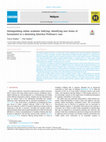
Heliyon, 2021
The shift of academic discourse to an online space without guardians gives motivated academic cyb... more The shift of academic discourse to an online space without guardians gives motivated academic cyberbullies an opportunity to harass susceptible recipients. Cyberbullying by higher education employees is a neglected phenomenon; despite the dangers it poses to academic free speech as well as other negative outcomes. In the absence of an adequate definition for Online Academic Bullying (OAB) as a surfacing threat, its’ targets cannot readily gauge its severity or confidently report that they are victims. Nor do their attackers have a reference point for understanding and, perhaps, correcting their own incivility.
To remedy this, we propose an analytical framework grounded in Routine Activity Theory (RAT) that can serve as an appropriate reporting instrument. The OABRAT framework is illustrated with an Emeritus Professor's case and the varied examples of cyber harassment that he experienced. This scientific influencer was relentlessly attacked on social media platforms by varied academics for expressing contrarian, but evidence-based, opinions. Spotlighting OAB's distinctive attacks should raise awareness amongst researchers and institutional policy makers. The reporting instrument may further assist with identifying and confronting this threat.
This article also flags ethical concerns related to dissident scholars’ usage of online platforms for informal, public debates. Such scholars may face an asymmetrical challenge in confronting cyber harassment from hypercritical academics and cybermobs on poorly moderated platforms. Universities should therefor consider appropriate countermeasures to protect both the public and their employees against victimisation by academic cyberbullies.
Social semiotics by Travis M Noakes
Data visualization in society, 2020
This chapter investigates the semiotic and rhetorical strategies for realizing argument in data v... more This chapter investigates the semiotic and rhetorical strategies for realizing argument in data visualizations produced by second-year journalism students. The semiotic strategies include use of colour, typography, graphics, and the rhetorical strategies include establishing credibility and the use of citation. The effect of the underlying basis for comparison of data on the argument is examined, as are the selection and processing of data. The chapter investigates the semiotic encoding of ideational material and the ways relationships are established within the discourse communities constructed in the data visualizations. This way of looking at academic argument has important implications for teaching these text-types in higher education in order to produce critical citizens; both in terms of production and critical analysis.
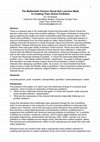
There is a research gap in the multimodal choices that Secondary School Visual Arts learners make... more There is a research gap in the multimodal choices that Secondary School Visual Arts learners make when using online portfolio software. This paper contributes to closing this gap by exploring the modes and modal combinations that three learners used in their varied online portfolios. These learners were chosen following a multimodal analysis of year-end screengrabs from the entire grade ten class' online portfolios. The educator's syllabus instructed all learners to create showcase Visual Arts electronic learning portfolios (e-portfolios). Despite following the same syllabus and using the same online portfolio software, there was great variety in learners' modal choices. These have been illustrated by showing how the divergent interests of three learners were reflected in multimodal choices that had different resonances with professional, school and teenage practices; as well as with online social networking practices. It was argued that the learners had created a 'Visual Arts Showcase Drawing E-portfolio', a 'Visual Arts Showcase Mixed Media Eportfolio' and a 'Teen Media Interest Portfolio', respectively. The paper's findings suggest that educators and other decision makers should accommodate a variety of student interests when designing e-portfolio syllabi. As a result, it is recommended that these syllabi include a broad and flexible range of guidelines. These should best enable learners to showcase the particular mediums, subject-matters or themes that their personal interests favour.
Online content creators by Travis M Noakes

Learning, Media and Technology journal, 2019
Despite the growing importance of digital portfolios for justifying creative work and study oppor... more Despite the growing importance of digital portfolios for justifying creative work and study opportunities, little is known about arts students’ creative appropriation of online portfolios in secondary school. In particular, there is a research gap concerning the challenges that young black women face when curating portfolios as visual arts students. This paper describes the key challenges that three such government school students negotiated when taught to creatively appropriate an online portfolio software for curating showcase visual arts e-portfolios:
In formal contexts, art students’ e-portfolios are strongly shaped by assimilatory norms. Visual arts students who want to develop portfolios that follow local or global crafts and fandoms must negotiate their low status in, or complete exclusion from, the national syllabus. Students in under-resourced school and home settings may already be using other online portfolio solutions that suit their purposes better than the particular software prescribed in arts lessons. Online portfolios are public by default and young women negotiated this risk by using pseudonymous self presentations. Each student’s classroom practices were also constrained by a technology selected for its minimalist exhibition aesthetic. Students curated showcase exhibitions, but the prescribed service did not facilitate a wider exploration of contemporary digital practices.
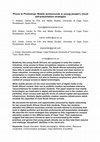
Relatively few young South Africans are equipped to enter the creative industries, since access t... more Relatively few young South Africans are equipped to enter the creative industries, since access to these occupations requires a combination of economic, social and cultural capital. The South African schooling system does little to assist students to overcome the income and class barriers to these industries. Increasing use of online portfolios for professional self-presentation in creative fields constitutes another key hurdle to tertiary studies at elite institutions and also to freelance employment, given the local context of unequal access to digital technologies. While mobile phones are the most accessible form of digital media in the South African context, their use in portfolio creation necessitates extensive resourcefulness for mobile-centric students. This paper explores how mobile technologies are implicated in digital self-presentation and in the creation of e-portfolios, which involve both specific forms of cultural capital and specialised infrastructure. Similarly digital portfolio creation requires infrastructure which exceeds the capacities of most South African schools. We document the barriers and opportunities presented by digital networking for two young South African Visual Arts students. These two students attended very different secondary schools but both learned to showcase their work in digital portfolios and develop professional self-presentation strategies. We describe the visual strategies they adopted as they negotiated an unequal education system in two different parts of Cape Town. Their experiences suggest that educators should be open to accommodating the mobile practices and genres that young people already use as they help them assume
and challenge ‘disciplined’ identities in the visual arts.
Keywords:
Design education, Mobile photography, Mobile-centric, Resource constraints, Communication ecologies, Class distinction, E-portfolio

As the boundaries between technology and social media have decreased, the potential for creative ... more As the boundaries between technology and social media have decreased, the potential for creative production or participatory practices have increased. However, the affordances of online content creation (OCC) are still taken up by a minority of Internet users despite the opportunities offered for engagement and creativity. Whilst previous studies have addressed creative production by university students for specific purposes, there is a research gap concerning OCC in the everyday lives of African university students. This paper describes the stories of three students who are online creators of content, the social media they utilised; their trajectories; their linkages with career interests; the types of online presences they created, maintained or discontinued into their university lives. As the case studies spanned digital practices that were informal and extracurricular yet peer supported as well as interest-driven and academically-oriented, the pedagogical framework of Connected Learning proved an appropriate heuristic. The study shows that being a digital creator gives students a competitive edge in our globally competitive society.
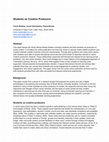
This paper follows two South African Media Studies university students and their activities as pr... more This paper follows two South African Media Studies university students and their activities as producers of online content. It considers the online publication services they chose to express media-related academic and creative interests outside of formal curriculum requirements. Through peer guidance and using online search, both students were able to access educational resources and communities of expertise relevant to varied creative production interests. These relationships supported self-directed and interest-driven learning across academic, civic and career domains. Such cross-linkages are a unique feature of the pedagogical approach of 'Connected Learning' , which knits together three crucial contexts for learning: peersupported, interest-powered and academically-oriented. It argues that learners flourish and achieve their potential when they can connect their interests and social engagement to academic studies, civic engagement, and career opportunity. This paper shows how the varied online publication services used by both students provided them with inter-connected and relevant extramural experiences.
PhD by Travis M Noakes

Proceedings of the 13th International Conference on e-Learning , 2018
Rather than focusing on institutional workarounds in ‘times of trouble’, our educational research... more Rather than focusing on institutional workarounds in ‘times of trouble’, our educational research explores the different challenges that arts students negotiated in curating their e-portfolios. We propose a ‘Capital meets Capabilities’ framework that combines Sen’s capability approach with Bourdieusian cultural sociology to situate students’ contrasting circumstances and repertoires. This framework describes how people make strategic use of their capital for developing a range of cultural and leisure repertoires. Visual arts e-portfolio curation is an example of participatory culture in which people’s designs can be strongly influenced by digital divides and other gaps. The gaps in participatory culture have not been conceptualised within a theoretical framework. To test whether a Capital meets Capabilities framework might be appropriate, we present a case study for “Masibulele”. He worked around scarcity in his parents’ household in the Khayelitsha township of Cape Town to became a fashion entrepreneur while studying at a high school. Despite having limited internet access, he taught himself to design fashion and shared this business via social networks. In curating an e-portfolio for the visual arts subject, he eventually included his fashion creations alongside those repertoires he was taught in arts class. The Capital meets Capabilities framework addressed the opportunities that Masibulele leveraged as an aspirant designer and fashion entrepreneur. The framework identified known gaps in participatory culture and suggested new ones related to cultural exclusion: Masibulele had to negotiate dominant cultural repertoires and taste regimes from a marginalized position. Unlike well-resourced emergent fashion designers, he was also heavily constrained. For example, he did not use his intermittent mobile-centric internet access to set up a presence on the most popular platforms for promoting fashion designs.

Inequality in Digital Personas, 2018
Digital and electronic learning portfolios (e-portfolios) are playing a growing role in supportin... more Digital and electronic learning portfolios (e-portfolios) are playing a growing role in supporting admission to tertiary study and employment by visual creatives. Despite the growing importance of digital portfolios, we know very little about how professionals or students use theirs. This thesis contributes to knowledge by describing how South African high school students curated varied e-portfolio styles while developing disciplinary personas as visual artists. The study documents the technological and material inequalities between these students at two schools in Cape Town. By contrast to many celebratory accounts of contemporary new media literacies, it provides cautionary case studies of how young people’s privileged or marginalized circumstances shape their digital portfolios as well. A four-year longitudinal action research project (2009-2013) enabled the recording and analysis of students’ development as visual artists via e-portfolios at an independent (2009-2012) and a government school (2012-2013). Each school represented one of the two types of secondary schooling recognised by the South African government. All student e-portfolios were analysed along with producers’ dissimilar contexts. Teachers often promoted highbrow cultural norms entrenched by white, English medium schooling. The predominance of such norms could disadvantage socially marginalized youths and those developing repertoires in creative industry, crafts or fan art. Furthermore, major technological inequalities caused further exclusion. Differences in connectivity and infrastructure between the two research sites and individuals’ home environments were apparent. While the project supported the development of new literacies, the intervention nonetheless inadvertently reproduced the symbolic advantages of privileged youths. Important distinctions existed between participants’ use of media technologies. Resourceintensive communications proved gatekeepers to under-resourced students and stopped them fully articulating their abilities in their e-portfolios. Non-connected students had the most limited exposure to developing a digital hexis while remediating artworks, presenting personas and benefiting from online affinity spaces. By contrast, well-connected students created comprehensive showcases curating links to their productions in varied affinity groups. Male teens from affluent homes were better positioned to negotiate their classroom identities, as well as their entrepreneurial and other personas. Cultural capital acquired in their homes, such as media production skills, needed to resonate with the broader ethos of the school in its class and cultural dimensions. By contrast, certain creative industry, fan art and craft productions seemed precluded by assimilationist assumptions. At the same time, young women grappled with the risks and benefits of online visibility. An important side effect of validating media produced outside school is that privileged teens may amplify their symbolic advantages by easily adding distinctive personas. Under-resourced students must contend with the dual challenges of media ecologies as gatekeepers and an exclusionary cultural environment. Black teens from working class homes were faced with many hidden infrastructural and cultural challenges that contributed to their individual achievements falling short of similarly motivated peers. Equitable digital portfolio education must address both infrastructural inequality and decolonisation.
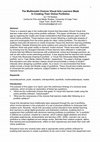
There is a research gap in the multimodal choices that Secondary School Visual Arts learners make... more There is a research gap in the multimodal choices that Secondary School Visual Arts learners make when using online portfolio software. This paper contributes to closing this gap by exploring the modes and modal combinations that three learners used in their varied online portfolios. These learners were chosen following a multimodal analysis of year-end screengrabs from the entire grade ten class' online portfolios. The educator's syllabus instructed all learners to create showcase Visual Arts electronic learning portfolios (e-portfolios). Despite following the same syllabus and using the same online portfolio software, there was great variety in learners' modal choices. These have been illustrated by showing how the divergent interests of three learners were reflected in multimodal choices that had different resonances with professional, school and teenage practices; as well as with online social networking practices. It was argued that the learners had created a 'Visual Arts Showcase Drawing E-portfolio', a 'Visual Arts Showcase Mixed Media Eportfolio' and a 'Teen Media Interest Portfolio', respectively. The paper's findings suggest that educators and other decision makers should accommodate a variety of student interests when designing e-portfolio syllabi. As a result, it is recommended that these syllabi include a broad and flexible range of guidelines. These should best enable learners to showcase the particular mediums, subject-matters or themes that their personal interests favour.











Uploads
Academic free speech and digital voices by Travis M Noakes
To remedy this, we propose an analytical framework grounded in Routine Activity Theory (RAT) that can serve as an appropriate reporting instrument. The OABRAT framework is illustrated with an Emeritus Professor's case and the varied examples of cyber harassment that he experienced. This scientific influencer was relentlessly attacked on social media platforms by varied academics for expressing contrarian, but evidence-based, opinions. Spotlighting OAB's distinctive attacks should raise awareness amongst researchers and institutional policy makers. The reporting instrument may further assist with identifying and confronting this threat.
This article also flags ethical concerns related to dissident scholars’ usage of online platforms for informal, public debates. Such scholars may face an asymmetrical challenge in confronting cyber harassment from hypercritical academics and cybermobs on poorly moderated platforms. Universities should therefor consider appropriate countermeasures to protect both the public and their employees against victimisation by academic cyberbullies.
Social semiotics by Travis M Noakes
Online content creators by Travis M Noakes
In formal contexts, art students’ e-portfolios are strongly shaped by assimilatory norms. Visual arts students who want to develop portfolios that follow local or global crafts and fandoms must negotiate their low status in, or complete exclusion from, the national syllabus. Students in under-resourced school and home settings may already be using other online portfolio solutions that suit their purposes better than the particular software prescribed in arts lessons. Online portfolios are public by default and young women negotiated this risk by using pseudonymous self presentations. Each student’s classroom practices were also constrained by a technology selected for its minimalist exhibition aesthetic. Students curated showcase exhibitions, but the prescribed service did not facilitate a wider exploration of contemporary digital practices.
and challenge ‘disciplined’ identities in the visual arts.
Keywords:
Design education, Mobile photography, Mobile-centric, Resource constraints, Communication ecologies, Class distinction, E-portfolio
PhD by Travis M Noakes
To remedy this, we propose an analytical framework grounded in Routine Activity Theory (RAT) that can serve as an appropriate reporting instrument. The OABRAT framework is illustrated with an Emeritus Professor's case and the varied examples of cyber harassment that he experienced. This scientific influencer was relentlessly attacked on social media platforms by varied academics for expressing contrarian, but evidence-based, opinions. Spotlighting OAB's distinctive attacks should raise awareness amongst researchers and institutional policy makers. The reporting instrument may further assist with identifying and confronting this threat.
This article also flags ethical concerns related to dissident scholars’ usage of online platforms for informal, public debates. Such scholars may face an asymmetrical challenge in confronting cyber harassment from hypercritical academics and cybermobs on poorly moderated platforms. Universities should therefor consider appropriate countermeasures to protect both the public and their employees against victimisation by academic cyberbullies.
In formal contexts, art students’ e-portfolios are strongly shaped by assimilatory norms. Visual arts students who want to develop portfolios that follow local or global crafts and fandoms must negotiate their low status in, or complete exclusion from, the national syllabus. Students in under-resourced school and home settings may already be using other online portfolio solutions that suit their purposes better than the particular software prescribed in arts lessons. Online portfolios are public by default and young women negotiated this risk by using pseudonymous self presentations. Each student’s classroom practices were also constrained by a technology selected for its minimalist exhibition aesthetic. Students curated showcase exhibitions, but the prescribed service did not facilitate a wider exploration of contemporary digital practices.
and challenge ‘disciplined’ identities in the visual arts.
Keywords:
Design education, Mobile photography, Mobile-centric, Resource constraints, Communication ecologies, Class distinction, E-portfolio